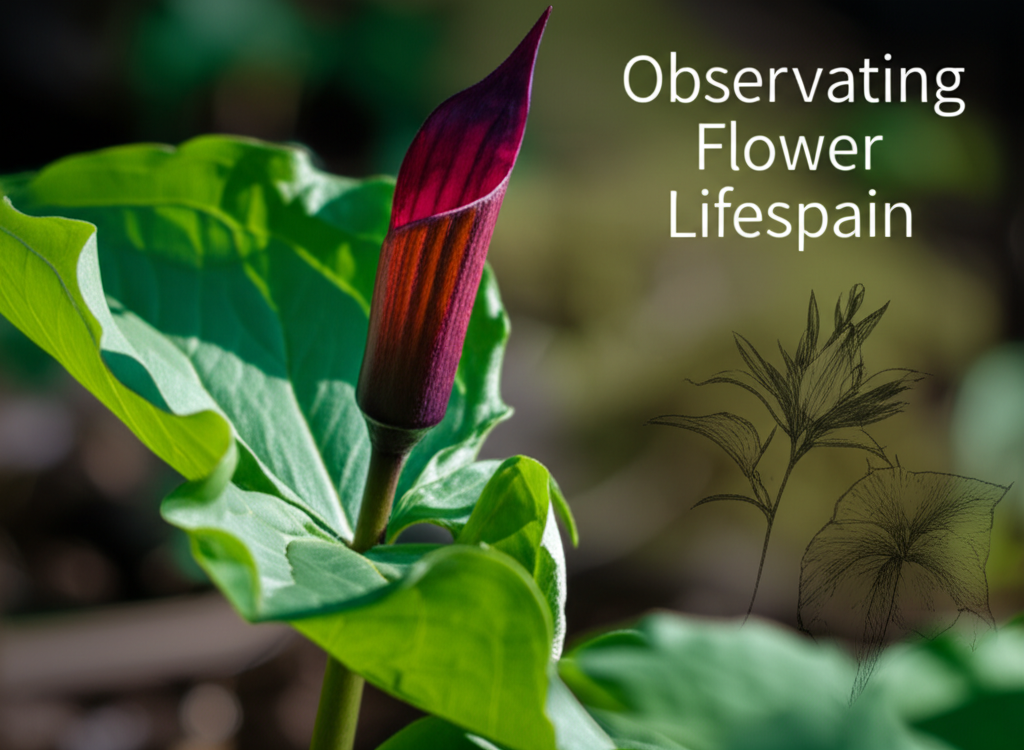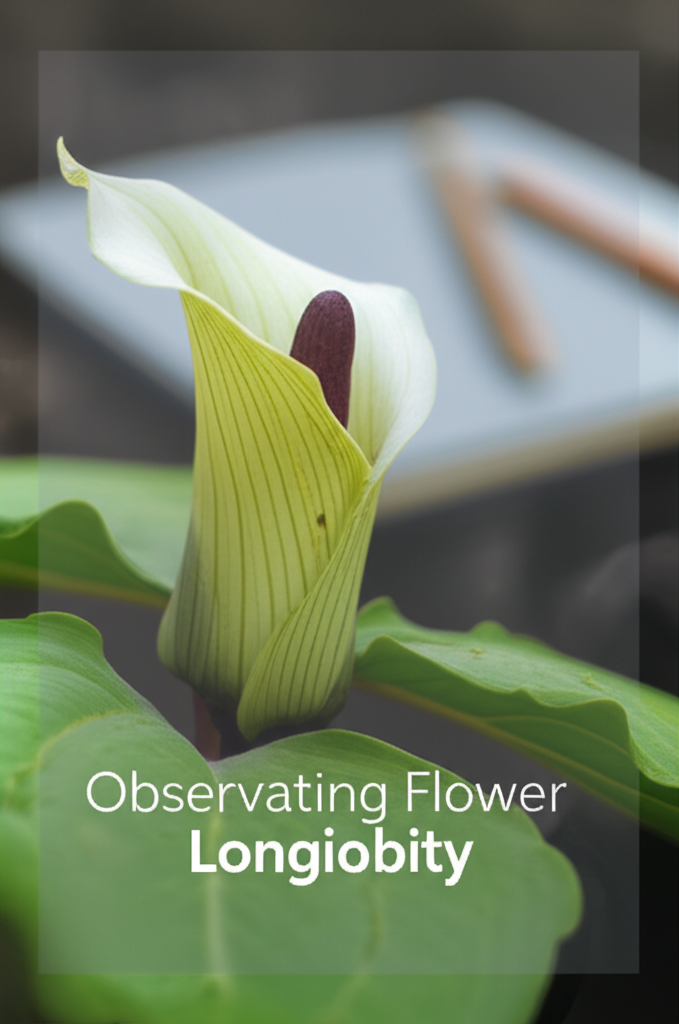Introduction: The Ephemeral Beauty and Persistent Mystery of the Jack-in-the-Pulpit
The Jack-in-the-Pulpit (Arisaema triphyllum) is a truly captivating woodland wildflower, instantly recognizable by its unique floral structure that resembles a preacher in a pulpit. While its distinctive appearance garners immediate attention, a lesser-discussed aspect of this fascinating plant is its longevity, both in terms of individual bloom lifespan and its perennial nature. Understanding how long a Jack-in-the-Pulpit flower remains intact, and how to effectively observe and document this phenomenon, is crucial for botanists, naturalists, and even dedicated garden enthusiasts. This article aims to provide a comprehensive exploration of Jack-in-the-Pulpit flower longevity, delving into the factors influencing it and outlining practical, factual methods for observation.
Understanding Jack-in-the-Pulpit Flower Anatomy: The Foundation of Longevity

Before we can discuss how long a Jack-in-the-Pulpit flower lasts, it’s essential to understand its anatomy. The “flower” is actually a complex inflorescence, a cluster of smaller flowers, enclosed within a spathe (the hooded structure) and a spadix (the central, finger-like appendage). This intricate design plays a significant role in its survival and reproductive strategy.
The Spathe: A Protective Canopy
The spathe, often green with purple or brown venation, is the most prominent part of the Jack-in-the-Pulpit. Its primary function is to protect the delicate reproductive parts within. The hood-like structure shields the spadix and the tiny flowers from harsh weather elements like heavy rain, wind, and direct sunlight. This protection is a key factor contributing to its relative longevity compared to more exposed blooms. The color and thickness of the spathe can vary, potentially influencing its resilience.
The Spadix: The Heart of the Inflorescence
The spadix, often described as the “Jack,” is a fleshy spike that bears the actual flowers at its base. It can range in color from green to deep purple or brown and may have a club-like tip. The spadix plays a role in attracting pollinators and also houses sterile male flowers at its tip, which can trap insects. The structural integrity of the spadix is vital for the overall lifespan of the inflorescence.
The Spathella (or Spathe Tube): The Inner Chamber
Beneath the main hood of the spathe, there’s often a further, more tubular spathe called the spathella. This encloses the fertile flowers, which are located at the very base of the spadix. The spathella adds another layer of protection, creating a microenvironment for pollination and seed development.
Factors Influencing Jack-in-the-Pulpit Flower Longevity
The lifespan of a Jack-in-the-Pulpit flower is not a fixed duration. It is influenced by a complex interplay of environmental, biological, and genetic factors.
Environmental Conditions: The Unseen Architects
- Temperature: Moderate temperatures are ideal. Extreme heat can cause the spathe to wilt and dry out prematurely, while prolonged cold can also hinder development and hasten senescence. Frost damage is particularly detrimental.
- Moisture: Consistent moisture in the soil is crucial for the plant’s overall health and, by extension, the longevity of its inflorescence. However, waterlogged conditions can lead to root rot, weakening the plant and reducing flower lifespan. Conversely, severe drought stress will cause the plant to shut down and the flower to senesce rapidly.
- Sunlight: While Jack-in-the-Pulpits prefer shady to partially shaded woodland environments, the intensity and duration of sunlight can impact flower longevity. Too much direct sun can scorch the spathe and lead to premature wilting.
- Wind: Strong winds can physically damage the delicate spathe and spadix, leading to a shortened lifespan.
Biological Factors: The Plant’s Own Processes
- Pollination Success: Once successfully pollinated, the energy of the plant shifts towards seed development. This can sometimes lead to a more rapid senescence of the spathe and spadix, as their primary reproductive function is completed.
- Pest and Disease Pressure: Infestations by insects or the presence of fungal diseases can weaken the plant and directly damage the inflorescence, drastically reducing its lifespan.
- Plant Vigor: A healthy, well-established plant with ample resources will generally support a more robust and longer-lasting flower than a stressed or younger specimen.
Genetic Predisposition: The Innate Blueprint
While environmental and biological factors are significant, there may also be inherent genetic differences between individual Jack-in-the-Pulpit plants that influence how long their flowers persist. Some plants may naturally produce more durable inflorescences than others.
Estimating Jack-in-the-Pulpit Flower Lifespan: A Range of Observations
It is challenging to assign a precise number to the lifespan of a Jack-in-the-Pulpit flower due to the variability of the factors mentioned above. However, based on numerous field observations and botanical literature, a general range can be established.
Typical Bloom Duration
Under optimal conditions, a Jack-in-the-Pulpit flower can remain aesthetically intact and structurally sound for approximately 2 to 4 weeks. This period typically begins from the time the spathe fully unfurls and stands upright, exposing the spadix.
Variations and Extremes
- Shorter Lifespans: In hot, dry conditions, or if the plant is stressed, the spathe might begin to wilt and shrivel within 7 to 10 days. Similarly, if pollination occurs very quickly and efficiently, the plant might direct resources away from the spathe sooner.
- Longer Lifespans: In cool, moist, and shaded environments, with minimal disturbance, some Jack-in-the-Pulpit flowers have been observed to persist for up to 5 or even 6 weeks, particularly before the development of the characteristic bright red berry cluster becomes fully apparent.
Observation Methods: Documenting Longevity in the Field and Garden
Accurate observation and documentation are key to understanding the longevity of Jack-in-the-Pulpit flowers. This involves systematic monitoring and recording of key stages.
Field Observation Techniques
- Site Selection and Reconnaissance: Identify a patch of Jack-in-the-Pulpits in their natural habitat or a garden setting. Note the general environmental conditions (shade, moisture, soil type).
- Marking Individual Plants: To track specific individuals, use non-damaging markers such as small, numbered tags placed a safe distance from the plant’s base. Alternatively, for more transient observations, take detailed photographic records with GPS coordinates.
- Regular Visit Schedule: Plan regular visits to the observed plants. The frequency of visits will depend on the expected lifespan and the rate of change. Initially, daily or every-other-day visits are recommended during the peak blooming period.
- Detailed Note-Taking: For each visit, record:
Date and time of observation.
Stage of the flower (e.g., bud, fully open spathe, spathe beginning to droop, spathe fully wilted, berry development).
Any noticeable changes in color, texture, or structural integrity.
Environmental conditions (temperature, recent rainfall, sunlight intensity).
Presence of pests or diseases.
- Photographic Documentation: Take clear photographs at each visit, ensuring consistent angles and lighting if possible. Include a scale in some photos for reference. Close-ups of the spathe and spadix are valuable.
Garden-Based Observation
For those cultivating Jack-in-the-Pulpits in their gardens, the observation methods are similar but offer more control over environmental factors.
- Planting Site Considerations: Choose a location that mimics their natural woodland habitat (dappled shade, moist, well-drained soil).
- Monitoring Plant Health: Regularly check for signs of stress, pests, or diseases. Adequate watering and mulching are crucial.
- Phenological Tracking: Use a calendar to mark the date of emergence, the first opening of the spathe, and subsequent changes. This can help predict flowering times in subsequent years.
Key Facts and Comparison of Observation Approaches
Here’s a summary of key facts regarding Jack-in-the-Pulpit flower longevity and a comparison of observation methods:
| Aspect | Detail |
|---|---|
| Scientific Name | Arisaema triphyllum |
| Common Names | Jack-in-the-Pulpit, Indian Turnip, Bog Onion |
| Typical Flower Lifespan (under optimal conditions) | 2-4 weeks |
| Factors Affecting Longevity | Temperature, moisture, sunlight, wind, pollination success, pests, diseases, plant vigor, genetics. |
| Stages of Observation | Budding, full bloom (spathe open), wilting, senescence, berry formation. |
| Primary Observation Tools | Notebook, pen, camera, measuring tape (optional for scale). |
| Observation Method | Pros | Cons | Best For |
|---|---|---|---|
| Field Observation (Marked Plants) | High ecological relevance, captures natural variation, long-term data potential. | Less control over environmental factors, potential for disturbance, requires travel. | Ecological studies, understanding natural population dynamics. |
| Field Observation (Photographic/GPS) | Non-intrusive, good for broad surveys, allows for remote data analysis. | Less precise for tracking individual plant changes over time without repeat visits to the exact spot. | Initial surveys, documenting widespread presence and general condition. |
| Garden-Based Observation | High control over environmental variables, easier repeat access, direct plant care. | May not reflect natural conditions perfectly, limited to cultivated specimens. | Horticulturalists, home gardeners, controlled experiments. |
Stages of Flower Senescence: What to Look For
As the Jack-in-the-Pulpit flower reaches the end of its functional life, several observable changes occur. Recognizing these stages is part of effective longevity observation.
The Beginning of the End: Subtle Shifts
- Slight Drooping: The spathe may begin to lose its upright posture and droop slightly.
- Color Fading: The vibrant greens and purples might start to dull or become less saturated.
- Texture Change: The spathe might feel less firm and more pliable or papery.
Advanced Senescence: Visible Decline
- Significant Wilting: The spathe becomes noticeably limp and may fold or curl inwards.
- Shriveling: The edges of the spathe might begin to dry out and curl.
- Decomposition: Fungal or bacterial activity can begin, leading to softening and eventual disintegration.
- Spadix Appearance: The spadix may also start to wilt or change color.
Post-Flower Stage: Berry Development
Crucially, the senescence of the spathe and spadix does not necessarily mean the end of the plant’s reproductive cycle. As the flower fades, the fertile flowers at the base of the spadix develop into bright red to reddish-orange berries, which are a key feature of the plant in late summer and fall. The lifespan of the berry cluster* is often longer than the spathe itself.
Ethical Considerations for Observation
When observing Jack-in-the-Pulpits in their natural habitat, it is imperative to adhere to ethical guidelines for minimizing disturbance.
- Stay on Trails: Avoid trampling vegetation or disturbing the soil.
- Do Not Collect Specimens: Unless you have specific permits for scientific research, leave plants in their natural environment.
- Minimize Handling: If marking plants, use the least invasive methods possible.
- Respect Wildlife: Be aware of other organisms that may inhabit the area.
Conclusion: Appreciating the Nuances of Jack-in-the-Pulpit Longevity
The Jack-in-the-Pulpit flower, with its unique form and fascinating lifecycle, offers a rewarding subject for observation. Its longevity, typically ranging from two to four weeks under favorable conditions, is a testament to its protective floral structure and the plant’s overall health. By employing systematic observation methods, meticulously recording data, and understanding the environmental and biological factors at play, we can gain a deeper appreciation for this captivating woodland inhabitant. Whether in the wild or in a carefully curated garden, the enduring enigma of the Jack-in-the-Pulpit continues to inspire curiosity and a desire to unravel the subtle rhythms of the natural world.


